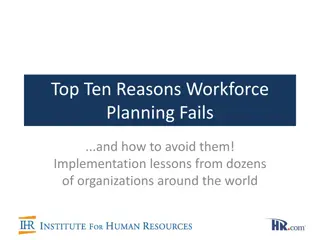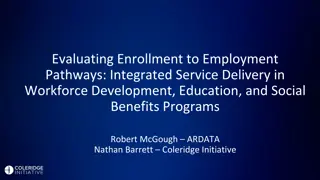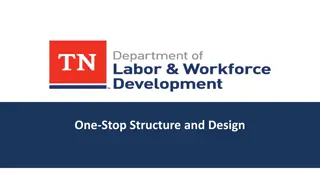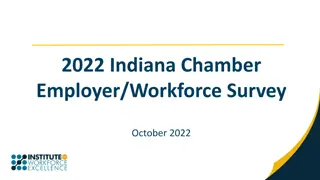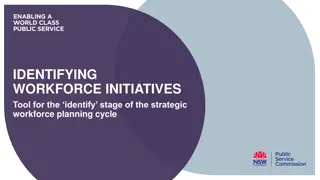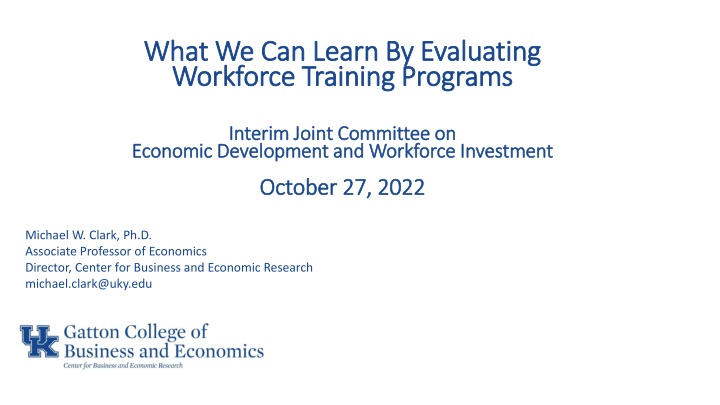
Workforce Training Program Evaluations for Economic Development
Explore the impact of evaluating workforce training programs on labor market outcomes and cost-benefit analysis. Learn about perspectives, measuring program impacts, and real-world examples. Discover how program evaluations can inform economic development strategies.
Uploaded on | 1 Views
Download Presentation

Please find below an Image/Link to download the presentation.
The content on the website is provided AS IS for your information and personal use only. It may not be sold, licensed, or shared on other websites without obtaining consent from the author. If you encounter any issues during the download, it is possible that the publisher has removed the file from their server.
You are allowed to download the files provided on this website for personal or commercial use, subject to the condition that they are used lawfully. All files are the property of their respective owners.
The content on the website is provided AS IS for your information and personal use only. It may not be sold, licensed, or shared on other websites without obtaining consent from the author.
E N D
Presentation Transcript
What We Can Learn By Evaluating What We Can Learn By Evaluating Workforce Training Programs Workforce Training Programs Interim Joint Committee on Interim Joint Committee on Economic Development and Workforce Investment Economic Development and Workforce Investment October 27, 2022 October 27, 2022 Michael W. Clark, Ph.D. Associate Professor of Economics Director, Center for Business and Economic Research michael.clark@uky.edu
Workforce Training Program Evaluations Evaluations attempt to answer two primary questions: 1. How do the programs affect labor market outcomes? Employment Wage Rates Hours worked Earnings 2. Do the benefits exceed the costs? Net Present Value Return on Investment 2
Different Perspectives Participants Perspective Costs Lost earnings during training Program tuition/fees Work related expenditures Lost of govt assistance Public Perspective Costs Program expenditures Reduced tax revenues (during training) Benefits Higher earnings Fringe benefits Benefits Increased tax revenue (post- training) Reduced social assistance 3
Example of Impact on Earnings 30 Prior to Training Without Training With Training Earnings ($ 000s) 25 20 Differences represent the program s impact on employment. 15 Training Period 4
Measuring Program Impacts Compare Outcomes of Participants (Treatment Group) to Non-participants (Control Group) Non-experimental Research Designs Control group Those with similar characteristics but did not participate Those who just missed the eligibility criteria Unobserved factors (e.g., motivation) could affect results Strong validity 5
Example of Impact on Earnings 30 Program Participants (Treatment Group) Prior to Training Without Training Earnings ($ 000s) With Training 25 Non-participants (Control Group) 20 15 Training Period 6
Example from Washington State Program Net Employment Impact (in Percentage Points) 4.1 7.4 6.7 Net Quarterly Earnings Impact $1,319 $1,455 $250* WIA Adults WIA Dislocated Workers WIA Youth * Not statistically significant. Impacts 9 to 12 quarters after exiting training program. Source: Hollenbeck, Kevin, and Wei-Jang Huang. Net Impact and Benefit-Cost Estimates of the Workforce Development System in Washington State. Employment Research 24(1): 1-4 2017. 7
Effects Might Differ Across Groups of Workers Low-skilled Minorities Female Younger workers Older workers Workers with disabilities Workers formerly incarcerated Programs Type of services/training provided Intensity of services/training Population served 8
Impacts Over Time 3 2.4 2.2 2.0 Net Benefits ($ 000s) 1.8 1.6 1.4 2 1.2 1.0 1 0 -1 -2 -3 -3.0 -3.0 -4 1 2 3 4 5 6 7 8 9 10 Year Future costs and benefits must be discounted and stated in their precent values. NPV = $5,500 NPV > 0 NPV < 0 Benefits exceed Costs Costs exceed Benefits 9
Example: Washington State WIA Dislocated Workers, Discounted Benefits & Costs First 2.5 Years Benefits Costs Net 23.7 25 20 Dollars (000s) 16.1 15 12.5 11.2 9.3 10 7.5 6.8 4.4 5 3.2 0 Participant Public Total Source: Hollenbeck, Kevin, and Wei-Jang Huang. Net Impact and Benefit-Cost Estimates of the Workforce Development System in Washington State. Employment Research 24(1): 1-4 2017. 10
Example: Washington State WIA Dislocated Workers, Discounted Benefits & Costs Lifetime Benefits Costs Net 125 100.6 100 89.4 Dollars (000s) 78.5 71.7 75 50 22.1 25 17.8 11.2 6.8 4.4 0 Participant Public Total Source: Hollenbeck, Kevin, and Wei-Jang Huang. Net Impact and Benefit-Cost Estimates of the Workforce Development System in Washington State. Employment Research 24(1): 1-4 2017. 11
Issues Short-term vs Long-term Effects Effects typically evaluated for 1 to 3 years Effects might decline over time Training more workers could affect labor markets Displace existing workers Reduce market wages 12
Workforce Training Program Evaluations Two primary questions: 1. How do the programs affect labor market outcomes? 2. Do the benefits exceed the costs? Answers allow policy makers to: identify weaknesses in the workforce development system allocate resources to the programs that yield the largest benefits 13




